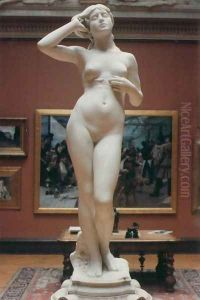Karl Peter Hasselberg Paintings
Karl Peter Hasselberg was a preeminent Swedish sculptor, born in 1850, whose work left a significant mark on the art world during the late 19th century, despite his relatively short life, ending in 1894. Hasselberg's contributions to sculpture are often celebrated for their delicate realism combined with an idealized vision that resonated with the artistic movements of his time, particularly with the Symbolist and neoclassical currents that were popular among European artists.
Growing up in a Sweden that was undergoing significant social and cultural transformations, Hasselberg was deeply influenced by the historic and natural beauty of his homeland, elements that would later permeate his artistic creations. His education in art began at the Royal Swedish Academy of Arts in Stockholm, where he honed his skills and developed a profound understanding of both classical and contemporary sculptural techniques. This period was crucial for Hasselberg, as it not only provided him with the technical prowess required to execute his visions in marble and bronze but also instilled in him a deep appreciation for the aesthetic ideals of antiquity, which he seamlessly blended with the modernist tendencies of his era.
Hasselberg's sculptures often depicted mythological themes, human figures, and allegorical subjects, executed with a sensitivity and attention to detail that made his works deeply emotive and visually captivating. One of his most famous sculptures, 'Snöklockan' (The Snowdrop), embodies the essence of his style—combining a profound sense of naturalism with a delicate, almost ethereal quality that elevates the subject matter beyond its physical form. This piece, among others, exemplifies Hasselberg's ability to capture the fleeting beauty of life and nature, making his work deeply resonant with audiences then and now.
Despite his career being cut short by his premature death in 1894, Karl Peter Hasselberg's legacy lives on through his sculptures, which continue to be celebrated for their beauty, technical excellence, and emotional depth. His work remains an important part of Sweden's cultural heritage and is featured in museums and collections both in his home country and internationally. Hasselberg's artistic achievements not only reflect the vibrant cultural milieu of 19th-century Sweden but also contribute to the broader narrative of European art, marking him as a notable figure in the history of sculpture.


![Nude [detail]](https://www.niceartgallery.com/imgs/191335/s/karl-peter-hasselberg-nude-detail-5f7f05c1.jpg)
![Snowlochen [from the side] (Snow Bell)](https://www.niceartgallery.com/imgs/191336/s/karl-peter-hasselberg-snowlochen-from-the-side-snow-bell-fc298368.jpg)
![Snowlochen [from the back] (Snow Bell)](https://www.niceartgallery.com/imgs/191337/s/karl-peter-hasselberg-snowlochen-from-the-back-snow-bell-2bcb0330.jpg)